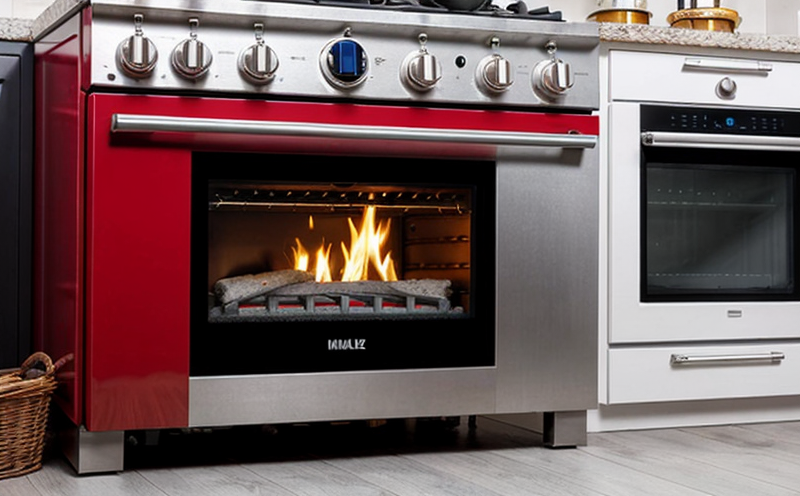IEC 60695-2-11 Glow-Wire Test for Appliance Materials
The IEC 60695-2-11 glow-wire test is a critical procedure used to evaluate the flammability of materials, particularly those found in household appliances. This test method simulates the conditions under which a material might come into contact with an ignition source—such as sparks or hot surfaces—which could lead to combustion.
The test involves subjecting a specimen to controlled heating using a glow-wire heater. The temperature of the heater is gradually increased until it reaches a specified value, typically 500°C to 750°C depending on the material's expected flammability range. During this process, the specimen is exposed to the hot wire, and its behavior—such as melting, burning, or dripping—is observed.
For household appliances like ovens, stoves, refrigerators, and washing machines, ensuring that component materials are flame-retardant is crucial for safety. Compliance with IEC 60695-2-11 helps manufacturers demonstrate that their products meet international standards, thereby protecting consumers from potential fire hazards.
The test results can provide valuable insights into the material's resistance to ignition and its overall flammability characteristics. This information is essential for quality assurance teams, R&D engineers, and compliance officers who need to ensure product safety and regulatory compliance.
Materials that pass this test are deemed suitable for use in environments where they may encounter an ignition source. The procedure covers a wide range of materials including plastics, rubber, textiles, and composites used in household appliances. It is particularly useful for identifying materials with low flammability properties, which are critical in preventing fires.
Test Parameters
The glow-wire test requires precise control over temperature and time to ensure accurate results. The heater wire's temperature must be carefully regulated within ±2°C of the specified value. Testing is typically conducted for a duration of 15 seconds, after which any flame or other combustion should extinguish itself.
Specimen Preparation
The specimen preparation involves cutting samples from the material to ensure they are representative of the actual product's surface area that may come into contact with an ignition source. The size and shape of the specimens vary depending on the type of appliance, but they must be consistent for each test batch.
Instrumentation
The glow-wire heater is a key component of this test. It consists of a tungsten wire that is heated to a specific temperature and held in place by a support mechanism. The heater's temperature is controlled using precise electronics, ensuring consistency across tests.
- Heater wire material: Tungsten
- Heating range: 500°C to 750°C
- Test duration: Typically 15 seconds
- Temperature control accuracy: ±2°C
Reporting and Compliance
The results of the IEC 60695-2-11 test are reported in a structured format, detailing the material's performance under the glow-wire conditions. Compliance with this standard is often required by regulatory bodies to ensure product safety.
For household appliances, compliance with IEC 60695-2-11 not only ensures that materials meet international standards but also enhances consumer confidence in the product's safety. This test plays a pivotal role in reducing fire risks and promoting safer home environments.
Why It Matters
The IEC 60695-2-11 glow-wire test is vital for ensuring the safety of household appliances. By evaluating materials' flammability, manufacturers can identify and mitigate potential fire hazards that may arise from contact with ignition sources such as sparks or hot surfaces.
Flammable materials in appliances could lead to dangerous situations if they ignite under normal operating conditions. The test helps manufacturers select flame-retardant materials that are less likely to catch fire, thereby protecting consumers and reducing the risk of property damage.
The glow-wire test is particularly important for components such as insulation, housing, and electrical connectors within appliances. These parts must withstand exposure to heat without catching fire or spreading flames rapidly. Compliance with this standard ensures that products meet international safety regulations and are suitable for use in the home environment.
In addition to enhancing product safety, compliance with IEC 60695-2-11 also provides a competitive advantage by demonstrating commitment to quality and regulatory standards. This can be particularly important for manufacturers looking to enter new markets or meet specific regional regulations.
Eurolab Advantages
EuroLab offers unparalleled expertise in conducting IEC 60695-2-11 glow-wire tests for household appliance materials. Our team of experienced engineers and technicians ensures that every test is conducted with precision, accuracy, and repeatability.
We provide comprehensive testing services tailored to meet the specific needs of our clients. From specimen preparation to final analysis, we ensure that all steps are performed according to international standards. Our state-of-the-art facilities and advanced instrumentation guarantee consistent and reliable test results.
Our commitment to quality and customer satisfaction is reflected in our ISO 17025 accreditation, which ensures that our testing processes meet the highest industry standards. This accreditation provides peace of mind for manufacturers who rely on us to verify the safety and compliance of their products.
EuroLab's experienced team offers deep technical expertise in materials science, electrical engineering, and product safety. We work closely with clients to understand their specific requirements and provide tailored testing solutions that meet both current and emerging standards.
Environmental and Sustainability Contributions
- EuroLab's adherence to international standards ensures the use of safe, non-flammable materials in household appliances, reducing the risk of fires and environmental damage.
- By promoting the use of flame-retardant materials, we help manufacturers design products that are safer for consumers and more environmentally friendly.
- The glow-wire test plays a crucial role in minimizing waste by ensuring that only safe and reliable materials reach the market. This reduces the likelihood of product recalls and associated environmental impacts.





